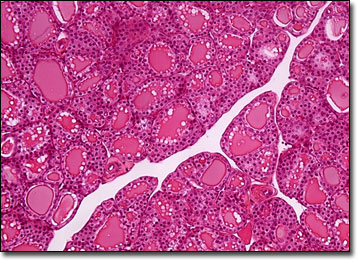Brightfield Microscopy Digital Image Gallery
Thyroid Gland
The thyroid is an endocrine gland situated in the throat that produces hormones that are involved in various functions within the body. Comprised of two oblong lobes linked by a narrow piece of tissue called the isthmus, the thyroid contains millions of small sac-like follicles that store the important substances.

View an image of the thyroid gland section at 10x magnification.
Within the thyroid follicles, hormones are stockpiled in the form of the glycoprotein thyroglobulin. Before the substances are secreted into the bloodstream through the capillaries, however, they are primarily converted into thyroxine, although smaller amounts of other related hormones are also generated. The quantity of the hormones that are produced chiefly depends upon the amount of thyroid-stimulating hormone released by the pituitary gland. Through an effective feedback mechanism the level of thyroxine within the body usually stays within a steady range, but various conditions, as well as an insufficient supply of iodine in the body, may result in too much or too little production, leading to a variety of disorders.
Though the specific effects of the hormones secreted by the thyroid are various, their most important role in adults is regulating metabolic processes. In children, thyroid hormones also play an essential role in proper growth and development. Thus, a deficiency in thyroid secretion in childhood is associated with both dwarfism and mental deficiencies. Goiter, a disease characterized by the enlargement of the thyroid gland to such an extent that a sizable lump appears at the front of the neck making swallowing and breathing difficult, is also caused by inadequate levels of thyroxine. Hyperthyroidism, or excessive secretion by the thyroid, however, is most commonly manifested as Gravesí disease.
BACK TO THE BRIGHTFIELD MICROSCOPY IMAGE GALLERY
